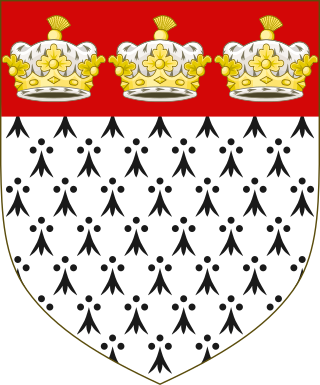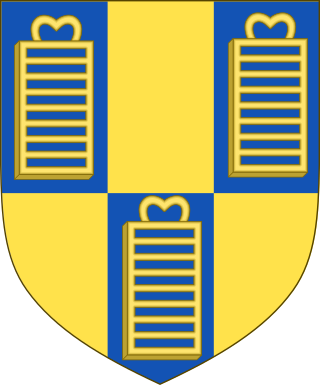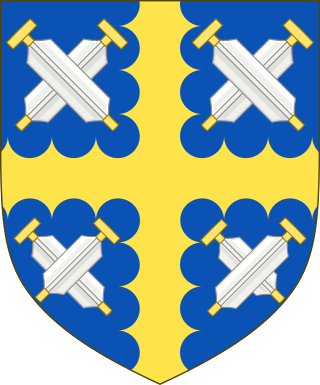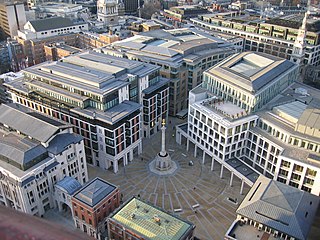
The Worshipful Company of Skinners is one of the Livery Companies of the City of London. It was originally an association of those engaged in the trade of skins and furs. It was granted Royal Charter in 1327.

The Worshipful Company of Drapers is one of the 111 livery companies of the City of London. It has the formal name The Master and Wardens and Brethren and Sisters of the Guild or Fraternity of the Blessed Mary the Virgin of the Mystery of Drapers of the City of London. More usually known simply as the Drapers' Company, it is one of the historic Great Twelve Livery Companies and was founded during the Middle Ages.

The Worshipful Company of Ironmongers is one of the Great Twelve livery companies of the City of London, incorporated under a Royal Charter in 1463.

The Worshipful Company of Clothworkers was incorporated by Royal Charter in 1528, formed by the amalgamation of its two predecessor companies, the Fullers and the Shearmen. It succeeded to the position of the Shearmen's Company and thus ranks twelfth in the order of precedence of Livery Companies of the City of London.

The Worshipful Company of Cutlers is one of the ancient Livery Companies of the City of London. It ranks 18th in the order of precedence of the Companies.

The Worshipful Company of Pewterers is one of the 111 Livery Companies of the City of London. It ranks 16th in the order of precedence of City Livery Companies and has existed since at least 1348. Like all the other City Livery Companies, the Worshipful Company of Pewterers has four main pillars of activity: Charitable endeavour, assistance to education, support for its trade and profession, and being a convivial and caring social community.

The Worshipful Company of Leathersellers is one of the livery companies of the City of London. The organisation originates from the latter part of the 14th century receiving its Royal Charter in 1444, and is therefore the senior leather industry-related City Livery Company.

The Worshipful Company of Armourers and Brasiers is one of the livery companies of the City of London. The Armourers' Guild was established in 1322; it received a royal charter in 1453. Other companies, including the Armour Repairers, merged with the Armourers. In 1708, brass workers joined the company, which was renamed as the Armourers' and Brasiers' Company. The company does support the metallurgy industry, but does not retain a close association with its original trade, as is the case with a majority of livery companies. It exists primarily as a charitable establishment.
The Worshipful Company of Wax Chandlers is one of the oldest livery companies of the City of London, with one of the smallest memberships.

The Worshipful Company of Girdlers is one of the Livery Companies of the City of London.

The Worshipful Company of Butchers is one of the Livery Companies of the City of London, England. Records indicate that an organisation of butchers existed as early as 975; the Butchers' Guild, the direct predecessor of the present Company, was granted the right to regulate the trade in 1331. The Butchers' Guild was incorporated by Royal Charter centuries later, in 1605. The Butchers' still, unlike other Livery Companies, continues to exist as a trade association for members of the industry, instead of evolving into an institution primarily dedicated to charity. However, the Company does contribute, like all Livery Companies, to various charities.

The Worshipful Company of Saddlers is one of the Livery Companies of the City of London. A Guild of Saddlers, the Company's predecessor, is thought to have been an Anglo-Saxon Craft Guild – it certainly existed at some point in the eleventh century. The Guild became a Company when a Royal Charter of Incorporation was granted by King Edward III in 1363. The City granted the Company the right to regulate the trade of saddle-making; all saddlers in and within two miles of the City were subject to the Company's regulations. However, the powers of the Company, which has existed on the same site at Cheapside since 1160, were eroded over time.

The Worshipful Company of Glovers is one of the ancient Livery Companies of the City of London. Glovers separated from the Cordwainers to form their own organisation in 1349 and received a Royal Charter of incorporation in 1639. The company is, as are most other Livery Companies, a charitable organisation, but it still retains close links to its original trade.

The Worshipful Company of Carpenters is a livery company of the City of London. The Carpenters were traditionally different from a fellow wood-crafting company, the Worshipful Company of Joiners and Ceilers, in that carpenters utilised nails while joiners used adhesives to attach wood.

The Worshipful Company of Painter-Stainers is one of the livery companies of the City of London. An organisation of painters of metals and wood is known to have existed as early as 1283. A similar organisation of stainers, who generally worked on staining cloth for decorative wall hangings, existed as early as 1400. The two bodies merged in 1502; the new organisation was incorporated under a Royal Charter in 1581.

The Worshipful Company of Curriers is one of the ancient livery companies of London, associated with the leather trade.

The Worshipful Company of Coopers is one of the livery companies of the City of London. The organisation of coopers existed in 1422; the Company received its first royal charter of incorporation in 1501. The cooper trade involved the making of wine, beer, and spirit casks ; the Livery Company also functions as a charitable foundation, and supports two education establishments: the Coopers' Company and Coborn School of Upminster, Essex, and Strode's College of Egham, Surrey. The former was founded in the Ratcliffe area of London in 1536 and donated to the Company who have been involved with it ever since.

Goldsmiths' Hall is a Grade I listed building at the junction of Foster Lane and Gresham Street in the City of London. It has served as an assay office and the headquarters of London's goldsmith guild, the Worshipful Company of Goldsmiths, one of the livery companies of the City of London. The company has been based at this location since 1339, the present building being their third hall on the site.

Bread Street is one of the 26 wards of the City of London, the name deriving from its principal street, which was anciently the city's bread market; already named Bredstrate for by the records it appears as that in 1302, Edward I announced that "the bakers of Bromley and Stratford-le-Bow [London], and ones already living on the street, were forbidden from selling bread from their own homes or bakeries, and could only do so from Bread Street." The street itself is just under 500 ft in length and now forms the eastern boundary of the ward after the 2003 boundary changes.

Cordwainers' Hall was the livery hall of the Worshipful Company of Cordwainers, the City of London livery company for Cordwainers from 1316 until its destruction in 1941.





















